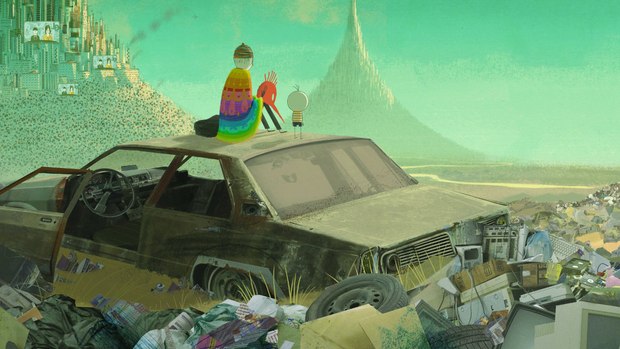The best way to watch ‘Boy & the World’ is to think of it as a non-narrative exercise and just enjoy the visuals.
Okay, so it’s beautiful to look at…so it’s won a pile (42, to be exact) of awards…so it’s gotten scads of thumbs-up reviews.
I still didn’t like it.*
I confess I left a screening ten or fifteen minutes into Boy & the World after a beautiful, colorful opening gave way to a long stretch of basically nothing happening against minimalist backgrounds. After reading some of the rave reviews and seeing stills from its more lively scenes I decided to give it another chance via a screener I could fast forward through its slower stretches.
But that’s just me. I almost walked out of Triplets of Belleville while the rest of the world was oohing and aahing over it, same thing with The Illusionist; I am not a fan of movies that allow you no emotional entry into the characters, or even go out of their way to block you. Which is my problem with Boy & the World. It’s hard to empathize with a protagonist who never speaks (no mouth to speak of, or with) and whose head is a white circle with vertical black slots for eyes. Those eyes occasionally shift or change shape to suggest emotions, but that’s about it. It also doesn’t help when his parents are equally featureless and look more like Mexican Day of the Dead ghosts than anything else. (If you want to see Day of the Dead characters who rock, check out The Book of Life, an astonishing animated feature snubbed by the Oscars.)
Maybe I shouldn’t be so hard on this movie. It is beautiful, gorgeous even, filled with unforgettable imagery. It’s just that the film keeps hinting at a story (Boy leaves the natural countryside in search of his father, travels to the soulless Big City and meets an assortment of unusual people along the way) without going to the trouble of actually providing one. Characters show up, hang around for a bit then vanish. There’s a wizened, forlorn old man who can barely drag his pushcart along; at last, a character you can feel some actual sympathy for—until Boy abandons him to continue searching for his dad.
In fact, this kid is having such a good time on his journey, his dad’s absence doesn’t really seem to weigh on him; besides, Dad seems to show up throughout the film and magically reappears home at film’s end. (Or does he? It’s never clear whether these moments are happening in Boy’s imagination or they’re really happening.)
I guess the best way to watch Boy & the World is to think of it as a non-narrative exercise and just enjoy the visuals: a traveling carnivàle appearing at random throughout the film…Boy running up endless favela stairways…highway signs, billboards and TV commercials, collages of upside-down, inside-out typography and fragmented photos…a pitch-black evil bird defeating a feathery, rainbow-colored one (with the aid of an entire army) in aerial battle…and in a feat of ingenuity that would leave Betty Boop’s pal Grampy impressed, a character upends his bicycle and festoons it with clanking junk, turning it into a percussion machine to accompany his flute performance. (It’s a playful melody that reoccurs throughout the film, a counterpoint to much of its grim imagery.)
A goodly portion of the film follows a crop being harvested, transported to a mill where it’s turned into a cotton-like fabric. An overhead shot of the harvest trees reveals them aligned in a perfect grid, the natural world turned into a commodity; workers, little more than tiny colored dots, buzz around each tree in perfect synchronization with all the others. (They’ve been dehumanized, turned into automatons, see?) It’s the same thing at the gigantic mill processing the crop, powered by endless rows of workers pulling on levers and pedaling stationary bicycles. When an evil corporation (that black bird’s its logo) buys the mill and replaces the workers with automated machines, are the workers heartbroken at being fired or elated at being freed from their drudgery? Who knows? But the scene of them traveling to work in endless identical groups is beautiful. (In certain ways the film owes a visual debt to Yellow Submarine.) Brazilian director Alê Abreu excels at computer-cloning characters and repeating them ad infinitum into synchronized patterns; in fact, one could almost say he’s dehumanizing his characters every bit as much as that evil corporation, or the military dictator we briefly glimpse.
Boy & the World switches to live action for scenes of forests destroyed by clear cutting and factories belching smoke, placing it squarely in the Koyaanisqatsi “nature good, civilization bad” school of filmmaking. Still though, Abreu found time for a hat tip to classic American cartoons when Boy, his eye glued to a kaleidoscope and ignoring everything else, strolls along rising steel beams and narrow girders of a construction site just as Bugs and Olive Oyl did in their day.
In his “Director’s Statement” Abreu explains the project began as an animated documentary composed of “various pieces” about South American exploitation at the hands of the industrial world; once he introduced Boy into its non-narrative the film turned fictional. He explains the ear-pleasing variety of music in its soundtrack as an attempt to give the film a “more universal tone,” including a Portuguese rap song “with lyrics [bringing] the voice of protest back to the film.” It would’ve been nice if there were English subtitles helping us understand that voice.
But that’s just me.
* Someone commented I didn’t express an actual opinion of The Good Dinosaur in my review;** I hope this one makes up for it.
** The nature stuff was beautiful, the characters were a lot of fun (especially the T-rexes) and the story was okay, kept things moving but nothing to write home about; overall I’d give The Good Dinosaur a B.








